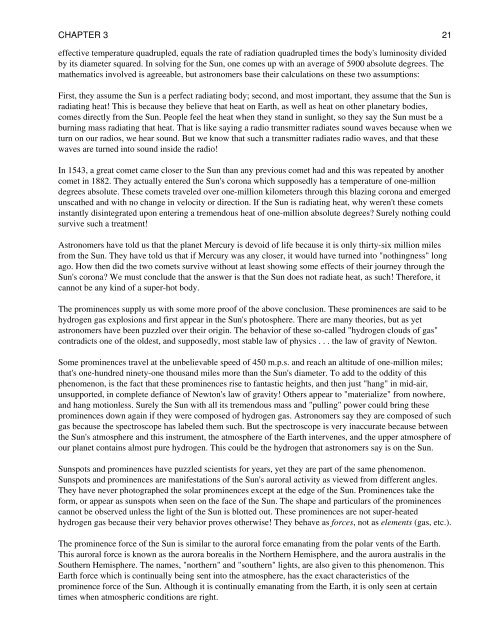CHAPTER 2 CHAPTER 3 CHAPTER 1 CHAPTER 2 CHAPTER 3 ...
CHAPTER 2 CHAPTER 3 CHAPTER 1 CHAPTER 2 CHAPTER 3 ...
CHAPTER 2 CHAPTER 3 CHAPTER 1 CHAPTER 2 CHAPTER 3 ...
Create successful ePaper yourself
Turn your PDF publications into a flip-book with our unique Google optimized e-Paper software.
<strong>CHAPTER</strong> 3 21<br />
effective temperature quadrupled, equals the rate of radiation quadrupled times the body's luminosity divided<br />
by its diameter squared. In solving for the Sun, one comes up with an average of 5900 absolute degrees. The<br />
mathematics involved is agreeable, but astronomers base their calculations on these two assumptions:<br />
First, they assume the Sun is a perfect radiating body; second, and most important, they assume that the Sun is<br />
radiating heat! This is because they believe that heat on Earth, as well as heat on other planetary bodies,<br />
comes directly from the Sun. People feel the heat when they stand in sunlight, so they say the Sun must be a<br />
burning mass radiating that heat. That is like saying a radio transmitter radiates sound waves because when we<br />
turn on our radios, we hear sound. But we know that such a transmitter radiates radio waves, and that these<br />
waves are turned into sound inside the radio!<br />
In 1543, a great comet came closer to the Sun than any previous comet had and this was repeated by another<br />
comet in 1882. They actually entered the Sun's corona which supposedly has a temperature of one-million<br />
degrees absolute. These comets traveled over one-million kilometers through this blazing corona and emerged<br />
unscathed and with no change in velocity or direction. If the Sun is radiating heat, why weren't these comets<br />
instantly disintegrated upon entering a tremendous heat of one-million absolute degrees? Surely nothing could<br />
survive such a treatment!<br />
Astronomers have told us that the planet Mercury is devoid of life because it is only thirty-six million miles<br />
from the Sun. They have told us that if Mercury was any closer, it would have turned into "nothingness" long<br />
ago. How then did the two comets survive without at least showing some effects of their journey through the<br />
Sun's corona? We must conclude that the answer is that the Sun does not radiate heat, as such! Therefore, it<br />
cannot be any kind of a super-hot body.<br />
The prominences supply us with some more proof of the above conclusion. These prominences are said to be<br />
hydrogen gas explosions and first appear in the Sun's photosphere. There are many theories, but as yet<br />
astronomers have been puzzled over their origin. The behavior of these so-called "hydrogen clouds of gas"<br />
contradicts one of the oldest, and supposedly, most stable law of physics . . . the law of gravity of Newton.<br />
Some prominences travel at the unbelievable speed of 450 m.p.s. and reach an altitude of one-million miles;<br />
that's one-hundred ninety-one thousand miles more than the Sun's diameter. To add to the oddity of this<br />
phenomenon, is the fact that these prominences rise to fantastic heights, and then just "hang" in mid-air,<br />
unsupported, in complete defiance of Newton's law of gravity! Others appear to "materialize" from nowhere,<br />
and hang motionless. Surely the Sun with all its tremendous mass and "pulling" power could bring these<br />
prominences down again if they were composed of hydrogen gas. Astronomers say they are composed of such<br />
gas because the spectroscope has labeled them such. But the spectroscope is very inaccurate because between<br />
the Sun's atmosphere and this instrument, the atmosphere of the Earth intervenes, and the upper atmosphere of<br />
our planet contains almost pure hydrogen. This could be the hydrogen that astronomers say is on the Sun.<br />
Sunspots and prominences have puzzled scientists for years, yet they are part of the same phenomenon.<br />
Sunspots and prominences are manifestations of the Sun's auroral activity as viewed from different angles.<br />
They have never photographed the solar prominences except at the edge of the Sun. Prominences take the<br />
form, or appear as sunspots when seen on the face of the Sun. The shape and particulars of the prominences<br />
cannot be observed unless the light of the Sun is blotted out. These prominences are not super-heated<br />
hydrogen gas because their very behavior proves otherwise! They behave as forces, not as elements (gas, etc.).<br />
The prominence force of the Sun is similar to the auroral force emanating from the polar vents of the Earth.<br />
This auroral force is known as the aurora borealis in the Northern Hemisphere, and the aurora australis in the<br />
Southern Hemisphere. The names, "northern" and "southern" lights, are also given to this phenomenon. This<br />
Earth force which is continually being sent into the atmosphere, has the exact characteristics of the<br />
prominence force of the Sun. Although it is continually emanating from the Earth, it is only seen at certain<br />
times when atmospheric conditions are right.






